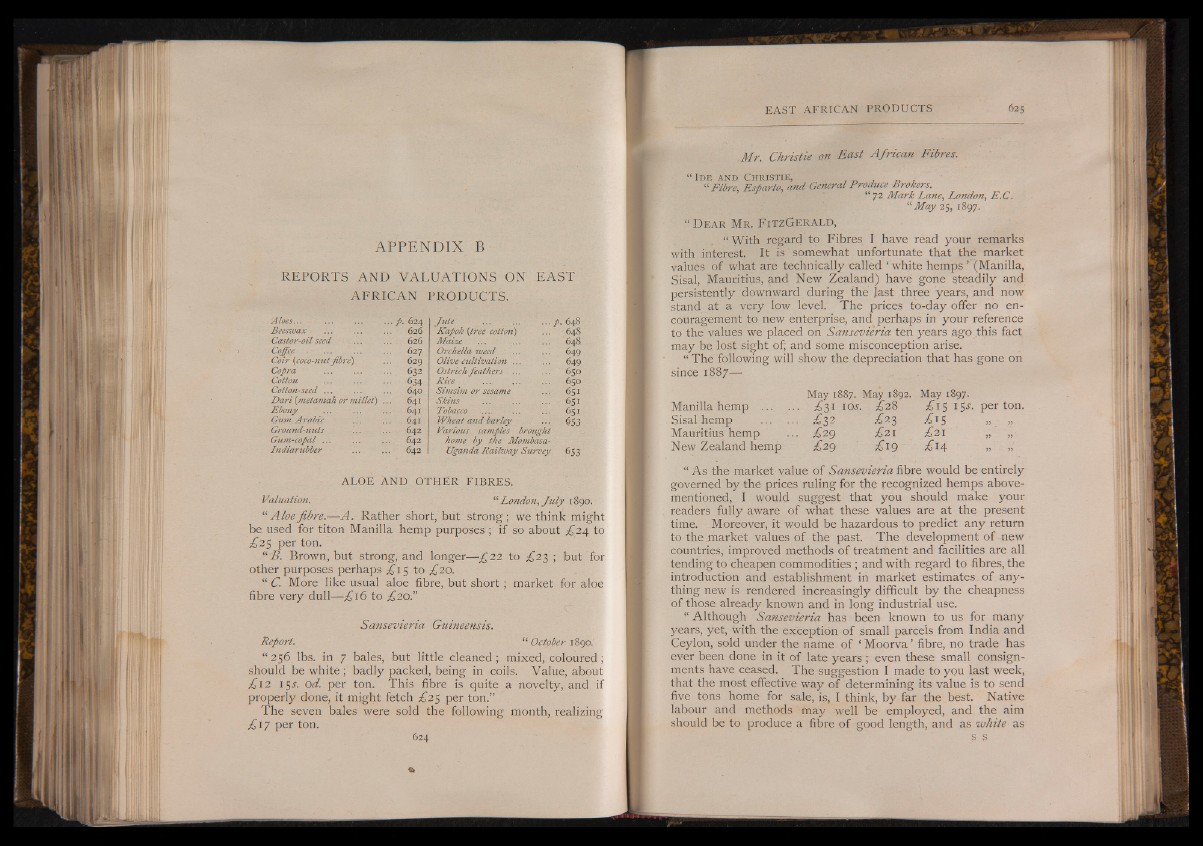
A P P END IX B
REPORTS AND V A LU A T IO N S ON E A ST
A FR IC AN PRODUCTS.
Aloes... ... . p. 624 Jute ... ... ... p. 648
Beeswax . 626 Kapok (tree cotton) 648
Castor-oil seed 626 Maize 648.
Coffee , . ............. 627 Orchelta weed 649
Coir (coco-nut fibre) 629 Olive cidtivation ... 649
Copra . 632 Ostrich feathers ... 650
Cotton • 634 Rice ... ... 650
Cotton-seed ... . . 640 Simsim or sesame 65*
Dari (metamah or millet) 641 Skins ... ... 651
Ebony ... ... 641 Tobacco .... ... 651
Gum Arabic ... 641 Wheat and barley 653
Gi‘ound-mits '... 642 Various samples brought
Gum-copal ... ... 642 home by the Mombasa-
Indiarubber 642 Uga7ida Railway Survey 653
ALOE AND OTHER FIBRES.
Valuation. “ London,July 1890.
“ Aloe fibre.— A . Rather short, but strong; we think might
be used for titon Manilla hemp purposes ; if so about £24 to
£2$ per ton.
“ B. Brown, but strong, and longer—£22 tó £23 ; but for
other purposes perhaps £15 to £20.
“ C. More like usual aloe fibre,, but short ; market for aloe
fibre very dull-—£16 to £20.”
Sansevieria Guineensis.
Report. “ October 1890.'
“ 256 lbs. in 7 bales, but little cleaned ; mixed, coloured ;
should be white ; badly packed, being in coils. Value, about
£\2 15 s. od. per ton. This fibre is quite a novelty, and if
properly done, it might fetch £25 per ton.”
The seven bales were sold the following month, realizing
£ 17 per ton.
.Mr. Christie on East African Fibres.
“ I d e a n d C h r i s t i e ,
S Fibre Esparto. and General Produce Brokers.
“ 72 Mark Lane, London, E .C .
“ May 25, 1897.
“ D e a r Mr . F it zGe r a l d ,
“ With regard to Fibres I have read your remarks
with interest. It is somewhat unfortunate that the market
values of what are technically called ‘ white hemps ’ (Manilla,
Sisal, Mauritius, and New Zealand) have gone steadily and
persistently downward during the jast three years, .and now
stand at a very low level. The prices to-day offer no encouragement
to new enterprise, and perhaps in your reference
to the values we placed on Sansevieria ten years ago this fact
may be lost sight of; and some misconception arise.
“ The following will show the depreciation that has gone on
since 1887—
May 1887. May 1892. May 1897.
Manilla hemp ... ... ¿31 i o a ¿28 X15 I 5J- Per ton.
Sisal hemp ........... £32 ^23 ^15 „ „
Mauritius hemp ... £29 £2\ £21 „ „
New Zealand hemp £ 2 9 £ 1 9 £ 14 . „ „
“ As the market value of Sansevieria fibre would be entirely
governed by the prices ruling for the recognized hemps above-
mentioned, I would suggest that you should make your
readers fully aware of what these values are at the present
time. Moreover, it would be hazardous to predict any return
to thejnarket values of the past. The development of new
countries, improved methods of treatment and facilities are all
tending to cheapen commodities ; and with regard to fibres, the
introduction and establishment in market estimates of anything
new is rendered increasingly difficult by the cheapness
of those already known and in long industrial use.
“ Although Sansevieria has been known to us for many
years, yet, with the exception of small parcels from India and
Ceylon, sold under the name of f Moorva ’ fibre, no trade has
ever been done in it of late years ; even these small consignments
have ceased. The suggestion I made to you last week,
that the most effective way of determining its value is to send
five tons home for sale, is, I think, by far the best. Native
labour and methods may well be employed, and the aim
should be to produce a fibre of good length, and as white as
s s